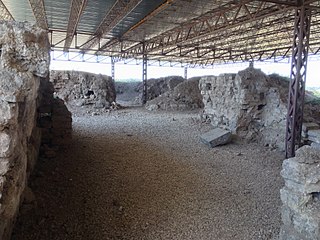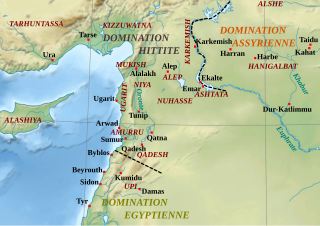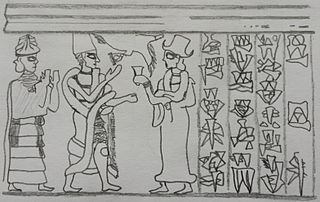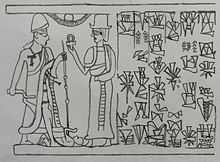
Yamhad (Yamḫad) was an ancient Semitic-speaking kingdom centered on Ḥalab (Aleppo) in Syria. The kingdom emerged at the end of the 19th century BC and was ruled by the Yamhad dynasty, who counted on both military and diplomacy to expand their realm. From the beginning of its establishment, the kingdom withstood the aggressions of its neighbors Mari, Qatna and the Old Assyrian Empire, and was turned into the most powerful Syrian kingdom of its era through the actions of its king Yarim-Lim I. By the middle of the 18th century BC, most of Syria minus the south came under the authority of Yamhad, either as a direct possession or through vassalage, and for nearly a century and a half, Yamhad dominated northern, northwestern and eastern Syria, and had influence over small kingdoms in Mesopotamia at the borders of Elam. The kingdom was eventually destroyed by the Hittites, then annexed by Mitanni in the 16th century BC.

Qatna was an ancient city located in Homs Governorate, Syria. Its remains constitute a tell situated about 18 km (11 mi) northeast of Homs near the village of al-Mishrifeh. The city was an important center through most of the second millennium BC and in the first half of the first millennium BC. It contained one of the largest royal palaces of Bronze Age Syria and an intact royal tomb that has provided a great amount of archaeological evidence on the funerary habits of that period.

Alalakh is an ancient archaeological site approximately 20 kilometres (12 mi) northeast of Antakya in what is now Turkey's Hatay Province. It flourished, as an urban settlement, in the Middle and Late Bronze Age, c. 2000-1200 BC. The city contained palaces, temples, private houses and fortifications. The remains of Alalakh have formed an extensive mound covering around 22 hectares. In Late Bronze Age, Alalakh was the capital of the local kingdom of Mukiš.

Nuhašše, also Nuhašša, was a region in northwestern Syria that flourished in the 2nd millennium BC. It was a federacy ruled by different kings who collaborated and probably had a high king. Nuhašše changed hands between different powers in the region such as Egypt, Mitanni and the Hittites. It rebelled against the latter which led Šuppiluliuma I to attack and annex the region.
Yarim-Lim I, also given as Yarimlim, was the second king of the ancient Amorite kingdom of Yamhad in modern-day Aleppo, Syria.
Sumu-Epuh is the first attested king of Yamhad (Halab). He founded the Yamhad dynasty which controlled northern Syria throughout the 17th and 18th centuries BC.
Hammurabi I is the third attested king of Yamhad (Halab).
Irridu (Irrite) was a city in northwestern Mesopotamia, likely located between Harran and Carchemish. It flourished in the middle and late Bronze Age before being destroyed by Assyria.

Abba-El I was the fourth great king of Yamhad (Halab), succeeding his father Hammurabi I.

Yarim-Lim II was the king of Yamhad succeeding his father Abba-El I.

Niqmi-Epuḫ, also given as Niqmepa was the king of Yamḫad (Halab) succeeding his father Yarim-Lim II.
Irkabtum was the king of Yamhad (Halab), succeeding his father Niqmi-Epuh.
Yarim-Lim III was the king of Yamhad (Halab) succeeding Hammurabi II.
Hammurabi II was an obscure king of Yamhad (Halab), probably reigning after Irkabtum.
Sarra-El also written Šarran was a prince of Yamhad who might have regained the throne after the assassination of the Hittite king Mursili I.

Abba-El II was the king of Halab who reigned after the withdrawal of the Hittites.
Ilim-Ilimma I was the king of Yamhad succeeding his father Abba-El II.
Hammurabi III was the king of Yamhad (Halab) succeeding Yarim-Lim III.
Hassum was a Hurrian city-state, located in southern Turkey most probably on the Euphrates river north of Carchemish.

Yarim-Lim was a king of Alalakh and son of Hammurabi I of Yamhad. He was granted the city of Alalakh by his brother Abba-El I of Yamhad and started a cadet branch of the Yamhadite dynasty that lasted until the conquest of Alalakh by the Hittite king Hattusili I.





























